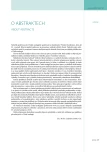Our first experiences with thermo-expandable shape-memory Memokath stents
Authors:
David Miklánek; Jan Doležel; Ivo Čapák; Martin Šustr; Daniel Macík
Authors‘ workplace:
Oddělení urologické onkologie, Masarykův
onkologický ústav Brno
Published in:
Ces Urol 2009; 13(3): 211-216
Category:
Case report
Overview
The objective of this article is to present our first experiences with insertion and follow up of nickel-titanium shape memory alloy stents Memokath (Engineers and Doctors, Denmark) in patients with long-term obstruction of urinary tract. We inserted 4 nickel-titanium shape memory Memokath stents from May to December 2006. All patients were men (mean age 69,5 years , range 47–87 years). The stents were inserted in urethral stricture in 3 cases (2 patients for BPH, 1 patient for stricture of bulbar urethra), last Memokath stent was inserted in a patient with ureteral stricture after radiotherapy for GIT tumour. The pacients were followed up for 8 months on the average (range 2–24 months). Decompression of urinary tract have achieved in all pacients. Memokath stent had to be removed in 2 cases: 1× for encrustation (from bulbar urethra, 5 months after insertion), 1× for spontaneous migration of stent (from ureter, 2 months after insertion). There was no problem in pacients with prostate Memokath stents. 1 pacient died due to cardial decompensation 9 months after insertion prostate Memokath stent. 1 patient has had no complication with prostate Memokath stent so far (24 months). Memokath stents has not been inserted in the Czech Republic before. Series of our patients is too small to draw reliable conclusions. We will indicate the insertion of Memokath stents in selected polymorbid or oncology patients in future too.
Key words:
Memokath stent, nickel-titanium shape memory, stricture.
Sources
1. Fabian KM. The intra-prostaic „partial catheter“ (urological spiral). Urologe A 1980; 19 : 236–238.
2. Flanigan RC, Reda DJ, Wasson JH, et al. 5-year outcome of surgical resection and watchful waiting for men with moderately symptomatic benign prostatic hyperplasia: a Department of Veterans Affairs cooperative study. J Urol 1998; 160 : 12–17.
3. Armitage J, Rashidian A, Cathcart J, Emberton M, van der Meulen J. The thermo-expandable metallic stent for managing benign prostatic hyperplasia: a systematic review. BJU Int 2006; 98 : 806–810.
4. Milroy EJ, Chapple CR, Copper JE, et al. A new treatment for urethral strictures. Lancet 1988; 1 : 1424–1427.
5. Milroy EJ, Allen A. Long-term results of UroLume urethral stent for recurrent urethral strictures. J Urol 1996; 155 : 904–908.
6. Wilson TS, Lemack GE, Dmochowski RR. Urolume stents learned. J Urol 2002; 167 : 2477–2480.
7. Saltzman B. Ureteral stents indications, variations and complications. Urol Clin North Am 1988; 15 : 481–491.
8. Lugmayr H, Pauer W. Self expanding metal stents for palliative treatment of malignant ureteral obstruction. Am J Radiol 1992; 159 : 1091–1094.
9. Kulkarni R, Bellamy E. A new thermo-expandable shape-memory nickel-titanium alloy stent for the management of ureteric strictures. BJU Int 1999; 83 : 755–759.
10. Arya M, Mostafid H, Patel H, Kellett M, Philp T. The self-expanding metallic ureteric stent in the long-term management of benign ureteric strictures. BJU Int 2001; 88 : 339–342.
Labels
Paediatric urologist Nephrology UrologyArticle was published in
Czech Urology

2009 Issue 3
Most read in this issue
- Ruptured kidney as complication of extracorporeal shock wave lithotripsy
- Our first experiences with thermo-expandable shape-memory Memokath stents
- BOTULINUM TOXIN: CURRENT USE IN UROLOGY
- Excursion to medical research information – impact factor and H-index
